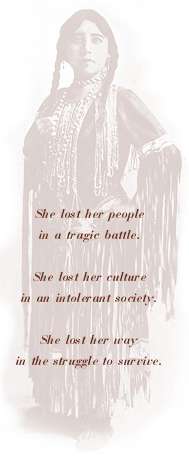About the Program
Late in the 19th century, a Lakota child survived a massacre and
was adopted by a prominent white couple, only to endure a life of racism, abuse
and poverty. Her poignant story is told in Lost Bird Of Wounded Knee. The
program is based on the acclaimed book, Lost Bird of Wounded Knee: Spirit of
the Lakota, by Renee Sansom Flood.
In the spring or summer of 1890, Lost Bird was born somewhere on the prairies
of South Dakota. Fate took her to Wounded Knee Creek on the Pine Ridge
Reservation on Dec. 29, 1890.
On that tragic day, some 300 Lakota men, women and children died as a result
of a confrontation with U.S. troops, and the woman who likely was the child’s
mother was among them. But as she was dying, she and her baby found some scanty
shelter from the bitter cold and wind. Four days after the massacre, a rescue
party found the infant, miraculously alive, protected by the woman’s frozen
body.
The baby was passed from one person to another and her sensational story
attracted the attention of powerful white men. Eventually, this "living
curio" of Wounded Knee ended up in the hands of an opportunistic Army
general, Leonard Colby, who adopted her without the knowledge or consent of his
suffragist wife, Clara Bewick Colby.
The tragic orphan had one big advantage - a mother who came to love her.
Clara Colby took on the duties of motherhood in addition to her work as a
suffragette activist, lecturer, publisher and writer. However, Zintka’s
childhood was marred by her exposure to racism from white society and abuse from
adoptive relatives. Poverty entered into the mix when Gen. Colby abandoned his
family for the child’s nursemaid/governess.
She bore a child out of wedlock and spent a year in a reformatory; married
three times; and traveled to South Dakota three times to seek her roots, only to
be rejected. At one point, she seemed to have found happiness in her first
marriage, but the relationship disintegrated when she discovered her new husband
had given her syphilis, then incurable. She struggled with the effects of that
illness for the rest of her life.
She had a number a careers during her short life: work with Buffalo Bill’s
Wild West Show, various entertainment and acting jobs, and possibly
prostitution. But much of her adult life was spent in poverty.
She fell ill in 1920, as an influenza epidemic swept across the nation. On
Feb. 14, Valentine’s Day, she died.
Lost Bird finally came home in 1991, in an effort spurred in part by author
Sansom Flood. Her remains were returned to South Dakota and buried at Wounded
Knee. Her tragic story led to the organization of the Lost Bird Society (http://lostbirdsociety.zintka.webjump.com)
which helps Native Americans, who were adopted outside their culture, find their
roots.
|



